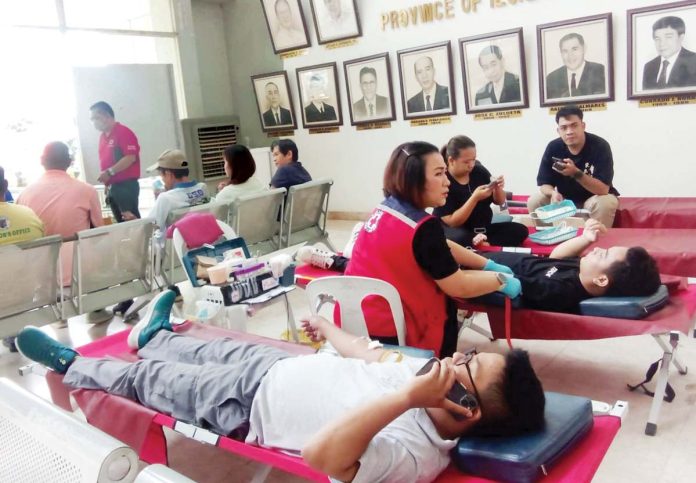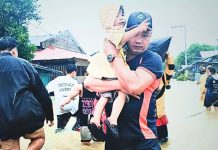
ILOILO – At first glance, a blood donation drive may seem like just another civic event—rows of chairs, folding beds, medical staff, and people lining up with forms in hand. But in Iloilo, this simple act has taken on a deeper meaning.
Every year during the last week of June, the country observes the National Organ and Blood Donation Awareness Week. In this province, the celebration was marked by a bloodletting activity at the provincial capitol grounds—a collaboration between the Provincial Health Office (PHO), Department of Health (DOH), and the Philippine Red Cross–Iloilo. Yet beyond the needles and donation bags are stories of courage, change, and community spirit.
For Engineer Argel Alasian, blood donation is personal. He started donating back in 2002.
“My wife had complications during childbirth, and that’s when I realized how vital blood is. From then on, I decided I’d donate whenever I could,” he shared.
Alasian, now an Engineer IV at the General Services Office of the capitol, is a familiar face in Red Cross activities. For him, it’s fulfilling.
“You’re not just giving blood — you’re giving someone a second chance at life,” he said.
Fulfilling, too, is how 52-year-old Jovil Feniola describes his experience. A three-year consistent donor, he sees bloodletting as both a responsibility and a source of wellness.
“It’s good for your health,” he said. “And it’s comforting to know that if someone close to you ever needs blood, you’re already prepared to help.”
His hospital visit during a time of shortage further deepened his commitment. He saw the need firsthand.
“I gave my blood, and since then, it’s become a part of who I am,” said Feniola.
Not everyone starts young. Some, like land title processor Sheila Buid, only began donating recently—but they’re already believers.
“You can feel the difference. My body feels lighter, more active, more alive,” Buid said with a smile. “It’s as if the act itself brings healing.”
Buid is determined to spread the word: “To those who haven’t tried it—don’t be afraid. Donating blood makes you feel healthier and lets you help others at the same time.”
That sense of giving back resonates with Maribel Senaypan, 48, who showed up determined to do good.
“I came to help those who need it,” she said. “I also made sure I eat healthy—mostly vegetables, fish, and very little meat—so I can keep donating.”
Then there are first-timers like Jamie Ann Mediana from the PHO, who’ve been waiting for the right moment.
“Whenever we had a family member in the hospital, we would have to look for donors. Now, it’s my turn to give,” she explained. “It feels good to finally do this.”
Across all their stories, a common thread emerges: blood donation is not just an act of giving—it’s an act of growth. From better health and disciplined lifestyles to a deeper sense of empathy and civic duty, the rewards are profound.
Preparation, donors say, is crucial.
“Sleep early, eat fruits and vegetables, stay away from cigarettes and alcohol,” Buid advised. “You’re doing it for others, but also for yourself.”
These Ilonggos are not just saving lives. They are showing that the simple act of giving blood can ripple outward—changing habits, deepening values, and strengthening communities.
To donate blood, one must be between 18 and 60 years old, in good health, and have had at least eight hours of sleep.
Those on maintenance medication, like for high blood pressure, may still donate provided their blood pressure is stable at the time of screening.
BRACING FOR SPIKE IN BLOOD DEMAND
With dengue cases expected to spike this rainy season, the Philippine Red Cross (PRC) Iloilo Chapter has given its strongest assurance yet: there will be no shortage of blood for those in need.
As hospitals brace for a potential influx of dengue patients requiring transfusions, PRC-Iloilo says its stockpile — and its commitment — are ready to meet the challenge.
Dr. Carlo Nolan Carado, PRC-Iloilo Blood Center manager, said the center is fully capable of supplying blood to 26 hospitals across Iloilo City and the province.
“We can say we have sufficient blood supply for the different hospitals we serve throughout Iloilo,” Carado recently told Panay News.
The assurance comes as health authorities anticipate a seasonal rise in dengue infections from June to August. Severe cases of dengue often require blood transfusions, particularly of platelet concentrates.
Dengue is a viral infection transmitted through the bite of an infected female Aedes aegypti and Aedes albopictus mosquitoes. Symptoms usually begin three to ten days after the bite and include sudden high fever, severe headache, pain behind the eyes, joint and muscle pain, skin rashes, and bleeding such as nosebleeds or easy bruising.
In its more severe form, dengue can cause a dangerous drop in platelet count and internal bleeding, which may require hospitalization and blood transfusion.
In 2024, PRC-Iloilo exceeded its target collection of 25,000 blood units by gathering 31,000 units — enough to help over 35,000 patients.
This year, they are aiming for the same target, and as of midyear, they’ve already collected around 15 percent.
Carado is optimistic the chapter will surpass the goal again. He attributed the steady increase in blood collections to active partnerships with local government units (LGUs), schools, nongovernment organizations, and the private sector, all of whom regularly organize bloodletting drives.
He also observed a sharp rise in blood donations after the May 12, 2025 midterm elections, once LGU operations returned to full swing.
“Thanks to the continuous advocacy of our partners, more Ilonggos are now willing to donate blood during barangay-level drives,” he added.
The PRC-Iloilo Blood Center on Bonifacio Drive, Iloilo City, is open daily for walk-in donors and can accommodate up to 20 individuals per day.
It also conducts daily mobile blood donation drives, with all blood collected processed into components depending on medical needs.
“I am asking the help of every Ilonggo. For every unit of blood donated, three lives can be saved. Let’s keep this life-saving advocacy going,” Carado emphasized.
World Blood Donor Day was celebrated last June 14./PN





